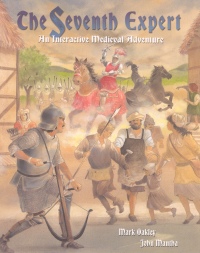| ________________
CM . . .
. Volume XV Number 3. . . .September 26, 2008
excerpt:
Well researched and tested, The Seventh Expert, a combination of storytelling and an interactive game, is designed to teach middle school readers about the Middle Ages. The story begins in 1362 when the fictional town of Port Haven, located on the coast of England near the Irish Sea, is destroyed by a violent storm. Survivors are forced to move inland and rebuild their community. Six experts- a knight, a homestead elder, a master carpenter, an archer/hunter, a blacksmith and a leatherworker- represented by both genders, are on hand to offer their advice on the move and the creation of a new settlement. The seventh expert is the reader whose role as leader makes him or her responsible for major decisions affecting the group. Thus the game begins. Following two pages of instructions on how to play, the book is divided into seven chapters, each one representing one year in the life of the people and focusing on a specific problem or hardship they face. At the end of each chapter, there are instructions for further play. Basically, the game is a combination of chance (a roll of the die), decision-making, critical thinking and problem-solving. An experts' catalog, located at the back of the book, provides 60 items or resources from which to choose to enable the people's survival. Some examples are healing herbs, watchtowers, vertical water mills and catapults. Points are accumulated in three different categories: effort, supplies and defense. A die, a piece of paper and a pencil are required in order to play the game (downloadable charts for recording points are available on the Annick Press web site). Depending on the roll of the die and the reader's strategy, the game is different every time it is played.
Recommended. Gail Hamilton is a teacher-librarian in Winnipeg, MB.
To comment
on this title or this review, send mail to cm@umanitoba.ca.
Copyright © the Manitoba Library Association. Reproduction for personal
use is permitted only if this copyright notice is maintained. Any
other reproduction is prohibited without permission.
NEXT REVIEW |
TABLE OF CONTENTS FOR THIS ISSUE
- September 26, 2008.
AUTHORS |
TITLES |
MEDIA REVIEWS |
PROFILES |
BACK ISSUES |
SEARCH |
CMARCHIVE |
HOME |
